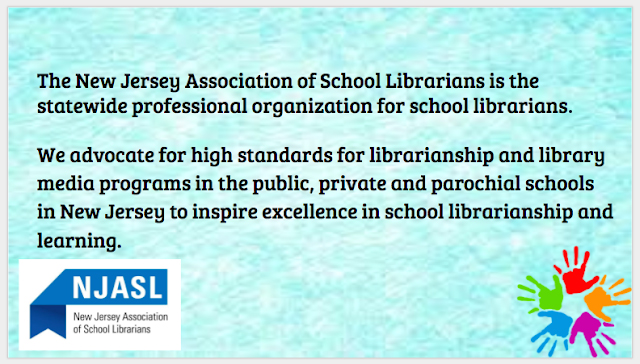This past week I had the pleasure of presenting to the New Jersey English Language Learners Advisory Committee on behalf of the New Jersey Association of School Librarians. This group included members of the Department of Education, ELL supervisors, and ELL teachers. My presentation was completed with the help of Mrs. Mary Moyer Stubbs who is our Legislative Consultant, various members of NJASL, and the NJ State Library.
I spent the beginning of my presentation talking about the importance of librarians and NJASL.
 Librarians and specifically New Jersey librarians are working with ELL students on a daily basis. Considering the average school’s ELL students make up ten percent of the student population, this is no surprise. Some of the areas we are specifically working with ELL students are: Collection Development, Translating Services, Open Access to the Library, Library Instruction, Collaborating, and Makerspaces.
Librarians and specifically New Jersey librarians are working with ELL students on a daily basis. Considering the average school’s ELL students make up ten percent of the student population, this is no surprise. Some of the areas we are specifically working with ELL students are: Collection Development, Translating Services, Open Access to the Library, Library Instruction, Collaborating, and Makerspaces.
Collection Development
School libraries, as well as public libraries, are adding books in other languages to their collection. Many librarians are also asking ELL students for input in this area. Interlibrary loan is also a really great resource, especially in these times when budgets are getting slashed. In addition to print books, audiobooks, ebooks, and databases are also being purchased. Many of these items are available in multiple languages, or they offer a translation feature. Graphic novels are also a fantastic resource for ELL students. They are high interest and the pictures can fill in the gaps for students. Sara Stevenson wrote an awesome article on using Graphic Novels with ELL students in AASL’s Knowledge Quest.
Translating Services
Librarians are helping ELL students with translating services. Many websites and databases offer translation features. I personally use MackinVIA to hold all of my library digital resources. Many of the electronic items that I have purchased directly from Mackin offer wonderful translating features on many of their electronic items. Librarians are also translating other items such as directions. One librarian from New Jersey I spoke to told me that she was able to get directions for computer coding in the Ukraine language.
Open Access to the Library
Libraries are one of the few places in a school or community that offer Open Access to all, and it is no different with ELL students. ELL students are pulled out of their academic classes and the library provides a safe spot for these students.
Library Instruction
Librarians are providing instruction to classes through information literacy lessons, technology lessons, and interactive storytimes. Many librarians are finding that they need to hand tailor their lessons and assignments so ELL students are included.
Collaborating
Collaborating with other teachers is nothing new for librarians. It has always been our job to work with other teachers, to help provide students with pertinent information for assignments. Many librarians are also forming alliances with school organizations that represent ELL students.
Makerspaces
I saved my favorite for last 🙂 This year I started a makerspace in my school library. One of my favorite things about the makerspace movement is students of all levels, languages, and ages can participate in making. Some of the benefits to makerspaces which specifically apply to ELL students include:
-
- Makerspaces democratize learning
- Makerspaces offer open access to all students
- Makerspaces offer authentic, real-world experiences for students
- Makerspace tools are created for speakers of all languages
• Bloxels – offers color-coded squares, which turns into a video game handmade by students.
• Little Bits – color coded by the kind of power
• Tinkercad – Software that works with 3D printers – works with shapes, not words
• LEGOs and K’nex
• Building with Cardboard
- Makerspaces provide opportunities for ELL students and non-ELL students to work together
Our state library also provides many services for ELL community members. Many of the public libraries are also providing services for their local community. Some of these services include:
- NJ Talking Book and Braille Center
- Fade to Books Program – a program that provides books to young boys and teens in urban sections of New Jersey
- ESL classes in New Jersey public libraries
- The state library has compiled a list of bilingual resources for New Jersey community members
In conclusion, this was a wonderful experience. I have presented all over the country, but so far this was the greatest honor I have had. I have included a copy of my presentation . It is important for other organizations to learn about libraries and all that we have to offer students and community members.






